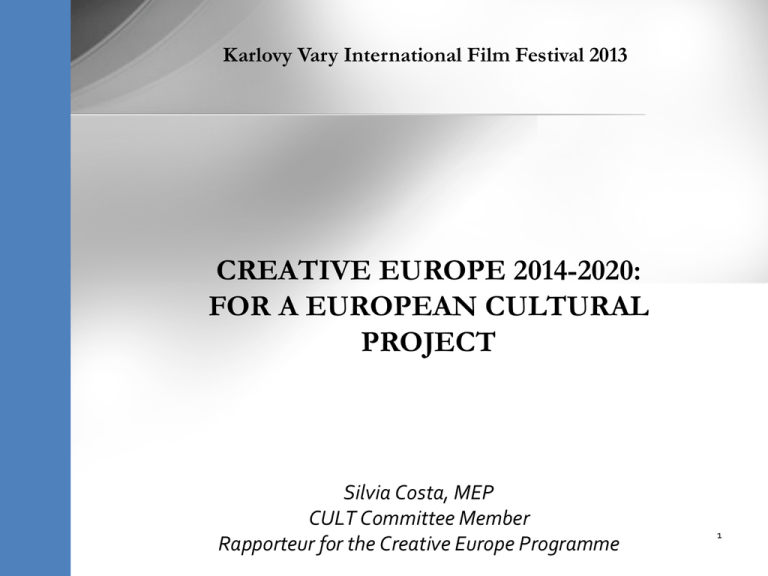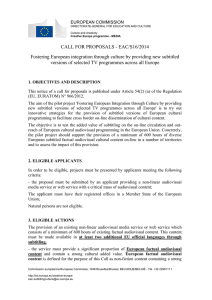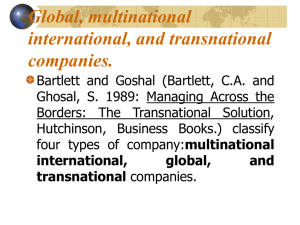Creative Europe 2014-2020
advertisement

Karlovy Vary International Film Festival 2013 CREATIVE EUROPE 2014-2020: FOR A EUROPEAN CULTURAL PROJECT Silvia Costa, MEP CULT Committee Member Rapporteur for the Creative Europe Programme 1 Cultural policy in Europe The legal basis: - Lisbon treaty, art. 167: The Union shall contribute to the flowering of the cultures of the Member States, while respecting their national and regional diversity and at the same time bringing the common cultural heritage to the fore. Action by the Union shall be aimed at encouraging cooperation between Member States and, if necessary, supporting and supplementing their action in improvement of the knowledge and dissemination of the culture and history of the European peoples, conservation and safeguarding of cultural heritage, non-commercial cultural exchanges, artistic and literary creation, including in the audiovisual sector[…], (Art. 166, vocational training, Art. 173, competitiveness of the Union's industry) - UNESCO Convention 2003 for the Safeguarding of the Intangible Cultural Heritage - UNESCO Convention 2005 on the Protection and Promotion of the Diversity of Cultural Expressions Generally, culture is strongly subjected to subsidiarity, in which the Eu action can support protection of heritage and cultural diversity THESE SAME PRINCIPLES INSPIRED OUR BATTLE TO KEEP THE CULTURAL EXCEPTION IN THE EU-US TRADE PACT 2 New Financial Framework: EU2020 EUROPE 2020 IS THE STRATEGY FOR A SMART, SUSTAINABLE, INCLUSIVE GROWTH. EU 2020 SETS THE OBJECTIVES FOR EUROPEAN UNION POLICIES. • The European Commission proposed the new Multiannual Financial Framework, which finances all European programmes. The total amount proposed was 1 trillions (1.000 billions) euro (lead to 960 billions during the latest Council) • The Council proposes a 3% budget cut; the European Parliament asks for the same amount than 2007- 2013. • The EC foresees a different sharing among headings, which would result in a 15% budget cut in heading 3, the one covering Creative Europe (i.e., from 1.8 billions to 1.4). • The negotiations among Parliament, Council and Commission on MFF and single programmes are currently ongoing. 3 Cultural policy in the 2014-2020 Financial Framework (1) In the new Framework, cultural policy can be found in the following areas: • Cohesion (Structural funds , budget: 376 billions) • Horizon 2020 (research and innovation, budget: 90 billions) • Digital Agenda (digital technologies, budget: 11 billions) • Rural Development (Budget: 92 billions, inside CAP, 389 billions) • Creative Europe (culture, creativity and audiovisual, budget: 1.8 billions) Projects: European Capitals of Culture, Cultural heritage label, programmes in cooperation with the Council of Europe (such as European cultural routes and Eurimages) 4 Cultural policy in the 2014-2020 Financial Framework (2) Thematic Objectives of Structural Funds: 1. STRENGTHENING RESEARCH, TECHNOLOGICAL DEVELOPMENT AND INNOVATION 2. ENHANCING ACCESS TO AND, USE AND QUALITY OF INFORMATION AND COMMUNICATION TECHNOLOGIES 3. ENHANCING THE COMPETITIVENESS OF SMES, THE AGRICULTURAL SECTOR (FOR THE EAFRD) AND THE FISHERIES AND AQUACULTURE SECTOR (FOR THE EMFF) 4. SUPPORTING THE SHIFT TOWARDS A LOW-CARBON ECONOMY IN ALL SECTORS 5. PROMOTING CLIMATE CHANGE ADAPTATION AND RISK PREVENTION AND MANAGEMENT 6. PROTECTING THE ENVIRONMENT AND PROMOTING RESOURCE EFFICIENCY 7. PROMOTING SUSTAINABLE TRANSPORT AND REMOVING BOTTLENECKS IN KEY NETWORK INFRASTRUCTURES 8. PROMOTING EMPLOYMENT AND SUPPORTING LABOUR MOBILITY 9. PROMOTING SOCIAL INCLUSION AND COMBATING POVERTY 10. INVESTING IN EDUCATION, SKILLS AND LIFELONG LEARNING 11. ENHANCING INSTITUTIONAL CAPACITY AND ENSURING AN EFFICIENT PUBLIC ADMINISTRATION CULTURE AND TOURISM ARE NOT INCLUDED IN THE OBJECTIVES, BUT ONLY IN THE KEY ACTIONS 5 Cultural policy in the 2014-2020 Financial Framework (3) In the beginning, no references to culture were included in HORIZON 2020 programme. Our amendments managed to add the following regulations: • INFORMATION AND COMMUNICATION TECHNOLOGIES […] Content technologies and information management: ICT for digital content, cultural industries and creativity; • CLIMATE ACTION, ENVIRONMENT, RESOURCE EFFICIENCY AND SUSTAINABLE USE OF RAW MATERIALS; […] The consequences of climate change and pollution […] are endangering the fragile cultural fabric of the communities which embody Europe's cultural heritage/[…] Activities shall focus on [...] assessing [...] in key socio-economic sectors (e.g. agriculture, energy, transport, tourism, built environment and cultural heritage) • INCLUSIVE SOCIETIES/[…] Social sciences and humanities research can play an important role here/ […] It is also essential to understand and explore as well as promote the access and preservation of Europe's vast cultural heritage /Innovative and reflective societies/promote cultural heritage and European identity RURAL DEVELOPMENT can provide for cultural services and interventions on heritage provided 6 that they are relevant for territorial development. Challenges 1. Globalisation, need of more Competition of european creative industry in a global market; 2. Digitalisation that is changing the classic value chain could be a new vehicle to improve access to culture and to find new ways to make creativity profitable; 3. A step forward against a heavily fragmented market; 4. A new approach to collect data; 5. Facilitating SMEs to access to credit and financing. 7 The context Green paper 2011 on ICC in Europe: •Sector workforce: around 6 milion people •Profits: 654 billion •Companies: 1.5 million •Quota on EU GDP: 4 - 7% (depends on the scope of the survey). KEA Study about Structural Funds utilization for cultural projects: An analysis of the impact of structural funds to improve competitiveness of cities and territories, to push local economies towards new infrastructures and services, and to connect localities to cultural, touristic and environmental legacies. 8 Creative Europe 2014-2020 Definition: «Creative Europe supports European sectors of culture and creativity». Defined as sectors where «activities are mostly based on cultural values and/or on artistic and creative expression, both market oriented and not». Those activities «include creation, production, distribution and conservation of goods and services connected to cultural expression and related education and management functions». This framework is based on: -A cross sectorial strand that includes a loan guarantee instrument, transnational cooperation policies and Creative Europe desks - Culture subprogramme, dedicated to cultural and creative arts sectors - Media subprogramme, dedicated to the audiovisual sector 9 European Added Value Considering both the intrisic and the economic value of culture, the framework program will support any action and activity that demonstrates a European added value: 1. the transnational character of the cultural and creative actions and activities and their impact on European citizens and their knowledge of cultures other than their own, which shall complement regional, national, international and other Union programmes and policies; 2. Creation of the economies of scale and critical mass which Union support fosters, creating a leverage effect for additional funds; 3. transnational cooperation between cultural and creative operators, including artists, stimulating more comprehensive, rapid and effective responses to global challenges and innovation, i.e. creating long-term and inclusive developments for the whole sector and new business models; 4. ensuring that proper account is taken of the conditions obtaining in the European cultural and creative sectors, in particular the situation in lowproduction-capacity Member States and/or EU regions with a restricted 10 geographical and/or linguistic area. Who can access Sectors: Architecture, archives, libraries, museums, tangible and intangible work of art, design, festivals, music, literature, performing arts, publishers, visual arts, audiovisual (short films, movies, documentaries, fiction, animation, kids movies, television, videogames, multimedia) Subjects: Cultural and creative operators: professionals, organization (profit and non profit), institutions, companies, SMEs (as defined by 2003/361/EC) that works in cultural and creative sectors. Countries: Member States, acceding countries, candidate countries and potential candidate countries , Switzerland, international partners, EFTA countries – members of EEA. The program is open to any other country or region that has cooperation agreements with the EU. 11 Objectives 1. To reinforce the capacity for the cultural and creative sector to operate on a transnational level and face new challenges, including the rise of digital content; 2. To promote transnational circulation of European works and operator mobility, specifically for artists; to better access to works of art in the EU while caring for young people, minorities and the disabled; 3. To reinforce the financial capacity of people employed in both sectors, with a strong regard for SMEs, and to ensure equality between women and men entrepreneurs 4. To support transnational policies and artistic cooperation targeted at reaching new audiences and supporting new business models. 12 Economic resources Budget proposed by Commission and EP: 1,8 billion Euros: - Media: 55% - Culture: 30% - Transsectorial strand: 15% (with loan guarantee and reinforcement of MEDIA Desk and Cultural Contact Points). The specific budget is included in the total financial framework which is now in discussion: the proposed cut is for 40 billions (from 1000 to 960 billions) 13 Actual position 18 December 2012: CULT Committee approves Costa Report (22 in favour out of 24 members) The trilogue with Council and Commission to negotiate the final text is ending Autumn 2013: Plenary Vote of EP 14 Transsectorial strand A) The loan guarantee is complementary to the grants, and it is open to cultural and creative SMEs that have their HQ in one of the countries that participate to the program. Loan schemes: investments for tangible and intangible assets, business transfers and working capital (interim finance, gap finance, tax incentives, cash flow, credit lines) B) Promotion of transnational cooperation policies, to: 1. Exchange experiences, knowledge and best practices 2. Gather new data and analyze markets 3. Participation in the European Audiovisual Observatory 4. Find new cross – sectorial developments, even in digital form, to finance, distribute and make a profitable use of creative works 5. Organize hearings, events and seminars on cultural,media and digital education 6. Teaching and enhancing the role of creative professionals C) Creative Europe Desks 15 Culture subprogrammme Support measures: 1. Transnational cooperation projects to unify different MS operators 2. Networking activities to connect operators from different MS to promote paneuropean events; 3. European actions to promote young talents and to improve artists mobility inside and outside of Europe 4. Literary translations 5. Special actions such as, European prizes, European Heritage Label and European capitals of culture. Note: support measures are tailored mostly for non profit projects 16 MEDIA Subprogramme – priorities 1. To enhance the European audiovisual sector by: a) Creating new competencies, developing networks, and promoting digital technologies and ensure adaptation in new markets b) Producing audiovisual projects to circulate within the EU, through coproduction and tv projects c) Encouraging exchanges and market access, creating better visibility for european works in international markets d) Facilitate European and international co-production of audiovisual works 2. To promote transnational circulation by: a) Helping cinema distribution b) Promoting trasnational marketing activities and distribution on different platform c) Stimulating audiences with promotions, events film literacy and festivals d) Helping European and international co-production partners to collaborate 17 e) Promoting new distribution models MEDIA subprogramme - measures a) Improve professional’s competencies and audience development b) Promotion of products with high potential transnational circulation, both in european and international market, also supporting dubbing and the use of subtitles c) Support activities of European audiovisual production companies, in particular of independent companies, and facilitate European and international co-productions of audiovisual works, including tv productions d) facilitate access to professional audiovisual trade events and markets and use of online business tools inside and outside Europe e) Support the distribution of non-national European films through cinema distribution platforms and all other platforms f) Facilitate circulation of European films worldwide and of international films in Europe on all platforms g) Support a European cinema owners network screening mostly European films including proportion of non-national European films h) Support initiatives, including festivals, presenting and promoting a diversity of European audiovisual works and the audiovisual and cinematographic heritage i) Support activities aiming at increasing audiences knowledge of and interest in European cinema, in particular activities aiming at promoting film literacy among young generations j) Support new business models 18








